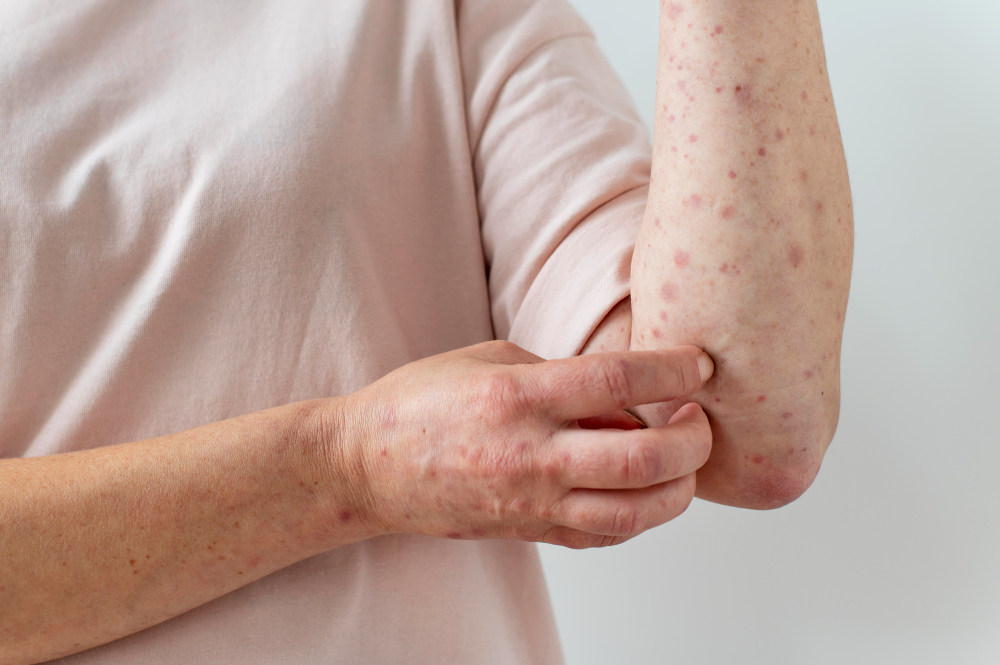Latex Allergy
Overview
Latex is a natural rubber that is made from the milky sap of the Hevea brasiliensis tree in Brazil. Latex is used to make a lot of different things, like medical gloves and IV tubing. There are even proteins like these in well-known foods.
When your immune system reacts to a harmless substance as if it were a virus or bacteria, this is called an allergy. Antibodies and chemicals, like antihistamines, are released and race to the point of invasion, where they cause an inflammatory immune response.
According to the Centers for Disease Control and Prevention,One to six percent of Americans are allergic to latex. A reaction to latex that is too much or too little can be mild or severe. It can even be dangerous to your life in some cases. This article will tell you more about the signs of a latex allergy and how to avoid getting this potentially dangerous condition.
What are the symptoms of a latex allergy?
Most of the time, people who are allergic to latex get a rash at the place where they touched it. This is called contact dermatitis. Some signs could be:
- itchy hands
- skin rash that may be warm to the touch
- hives
- eczema (denoted as weeping or cracking skin)
Most of the time, these feelings don’t last long. They might show up minutes after being exposed, or they might take a few hours. If you get a rash, you might need hydrocortisone cream or calamine lotion to make it feel better.
Proteins in latex can sometimes get into the air. When this happens, a person who is allergic to them might breathe them in without knowing it and have a worse reaction. Some of these are:
- swollen and red skin, lips, or tongue
- runny or stuffy nose
- shortness of breath (with or without wheezing)
- abdominal pain
- diarrhea
- vomiting
- rapid heartbeat
- dizziness
Anaphylaxis is a rare but life-threatening reaction to latex. The symptoms are similar to those of airborne allergies, but they are much worse. Anaphylactic shock can make it hard to breathe, lower your blood pressure, or even kill you if not treated.
Products that contain latex
Latex is found in a lot of things, including most things that can be stretched. Try to stay away from the following:
- Gloves, IV tubes, catheters, and blood pressure cuffs are all examples of medical tools.
- dental tools such as rubber bands for braces and dental dams
- condoms and diaphragms are forms of birth control.
- clothes with elastic bands, like running shoes, raincoats, and underwear
- Some household items, like zippered storage bags, bathmats, some rugs, and rubber gloves, are not made in the U.S.
- Items for babies and kids, like pacifiers, bottle nipples, disposable diapers, and toys that help with teething or other activities.
- Some school or office supplies, like rubber bands, erasers, tape, rubber cement, and paint, as well as elastic bandages, including Band-Aid brand bandages, are made with child labour.
- rubber balloons (mylar balloons are fine)
Latex cross-reactivity with certain foods
The American Academy of Allergy, Asthma & Immunology estimates that 50 percent of people with a latex allergy also have other kinds of allergies. Some people who are allergic to latex may also be allergic to some foods that have proteins that are similar to those in latex. We call this “cross-reactivity.”
Fruits and vegetables
Some people may have an allergic reaction to more than one of the foods below. Cross-reaction is more or less likely to happen with different foods.
Foods that have a strong link:
- avocados
- bananas
- kiwis
Foods that have a moderate link:
- apples
- carrots
- celery
- papayas
- melons
- tomatoes
- potatoes
Foods that don’t have a strong link:
- cherries
- figs
- grapes
- nectarines
- pineapples
- strawberries
- plums
Other foods
It’s also important to watch out for these other foods that might cause a cross-reaction:
- Almonds, cashews, chestnuts, hazelnuts, peanuts, pecans, walnuts, and so on are tree nuts and legumes.
- Wheat and rye are grains, and crab, lobster, and shrimp are shellfish.
If you have a bad reaction to any of the foods above, talk to your doctor about it.
People at the greatest risk for a latex allergy
There are a lot more healthcare workers with latex allergies than usual. In fact, the Asthma and Allergy Foundation of America says that between 8% and 17% of all healthcare workers have the allergy. It is thought that the main reason for the higher rates in this group is that they use and are around latex more.
Other people who are at a higher risk are:
- those who are allergic to more than one food
- hairdressers
- Children with spina bifida or who have had many surgeries
- people who need medical procedures like catheterizations often
- childcare providers
- People who serve food
- housekeepers
- people who work in places that make tyres or rubber
Treating a latex allergy
Since there is no cure for a latex allergy, the best thing to do is to stay away from it. If your symptoms are mild, your doctor may give you antihistamines to help. If you have a severe allergy to latex, you can use injectable epinephrine to keep from having a severe reaction anaphylaxis.
Reducing the risk of a latex allergy
Latex is so common in the modern world that it may be hard to stay away from it completely. Still, there are some things you can do to cut down on contact. These things are:
- using non-latex gloves, like vinyl gloves, powder-free gloves, hypoallergenic gloves, or glove liners.
- Telling daycare and healthcare providers (including dentists) about any latex allergies.
- Wearing a medical ID bracelet that lists any allergies.
Outlook
Most latex allergies don’t kill people. Limiting your exposure as much as possible is the best way to avoid getting sick. If you work with latex, this can be harder to do than it sounds. Still, if you take a few extra steps, you can avoid symptoms without changing how you live. Ask an allergist if your symptoms are bad enough that you should see a doctor.









Leave a Reply